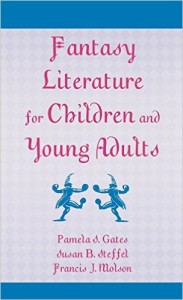 I love smarting myself up. Just read that last sentence; increasing my mental capacity is obviously a good idea. So whenever I see a book that promises to tell me something I don’t know, I’m interested. Especially when the topic is one that I’m already interested in. And I’ve always been a fan of fantasy in general, and of children/YA fantasy in particular. Fantasy Literature for Children and Young Adults is a mouthful of a title, but it’s also The Little Book That Could. The authors obviously know their subject, and they’re able to lay it out for readers by giving plenty of examples of the good stuff. Which in turn makes it good stuff all by itself.
I love smarting myself up. Just read that last sentence; increasing my mental capacity is obviously a good idea. So whenever I see a book that promises to tell me something I don’t know, I’m interested. Especially when the topic is one that I’m already interested in. And I’ve always been a fan of fantasy in general, and of children/YA fantasy in particular. Fantasy Literature for Children and Young Adults is a mouthful of a title, but it’s also The Little Book That Could. The authors obviously know their subject, and they’re able to lay it out for readers by giving plenty of examples of the good stuff. Which in turn makes it good stuff all by itself.
The nicely parceled out categories are understandable without being unwieldy. The authors keep it to three specific types: fairy tales, mixed fantasy and heroic-ethical traditions. These categories may not be as specific at most, but since since they mention that other methods of categorizations contain as many as twenty-three sub-types, I’m just fine with a certain loss of particulars. Each one gets a chapter to itself, with introductory and concluding statements to round out the book. At a little under 140 pages of discussion (subtracting end of chapter bibliographies), I was pleasantly surprised at just how much information they managed to fit in such a small book.
They do a great job of discussing fairy tales, and it’s a good thing; you never want your students to think you don’t know your stuff. It’s a nice overview, with the authors detailing most points thoroughly. The bibliography at the end of each chapter (as well as the more comprehensive one at the end of the book) lets readers know where they got their information. Good to know, and better to use as a research point for further study. There’s also a quick-and-dirty summation at the end of each chapter, which pulls things together, cleansing the palate for the next batch of information.
I’m happy to see certain examples of fantasy styles described so completely. But I’m also bummed that the authors describe the whole tale in most cases.Several of these works are stories I’ve never read before, and I would have liked to have had the opportunity to discover the twist and turns of these tales for myself. But this book isn’t to tempt the uninitiated into these stories. This book is meant to help those in the teaching or library profession, so giving them particular examples of subtypes, themes and storylines is more important than keeping the cat firmly in the bag. I can deal with that. Higher calling and so forth.
The authors challenge librarians and students of this genre to be open-minded in regards to the content of modern-day fairy tales. Sure, some recent works may bring up topics that don’t exactly chime with the oftentimes conservative listings most school libraries offer, but in order to make sure fantasy is relevent, it’s gotta be accessible to young readers, who are getting older and wiser every day. There’s also an argument to accept gothic fantasy as an integral part of the genre, an idea I wholly support. These tales also incorporate the battle between good and evil, usually at a much more obvious level.
The authors rattle off so many story tales that I felt like I had taken a crash course in children’s lit. And there were many instances where I made little notes to myself to head to the library and pick up some of the books they had mentioned. In the meantime, I’ll be patting myself on the back, having come away with a much broader understanding of this brand of fantasy literature than I had before. Knowledge is power? Well then, I’m feeling pretty strong right about now.
(Scarecrow Press, 2003)
